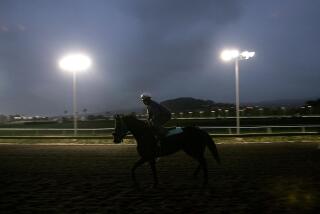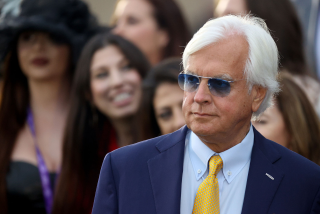Virginia’s Colonial Downs Is Struggling to Survive
When Colonial Downs opened before a large crowd on Labor Day in 1997, optimism about thoroughbred racing in Virginia lasted for one day. Since that time, almost every development at the track has been discouraging. Attendance dropped to levels that were frequently embarrassing. The quality of racing was poor. Business at a subsequent harness meeting was even worse. The track has been mired in debt and is fending off creditors.
Can Colonial Downs survive?
When the question was put to the track’s chairman, Jeffrey P. Jacobs, he said: “We’re going to have a thoroughbred meeting this fall.” That 25-day season is scheduled from Sept. 7 to Oct. 5. Beyond those dates, Jacobs said, “I think horse racing will survive in Virginia, but it may go through a financial restructuring.” The change, he said, is likely to take one of two forms: renegotiation of Colonial’s financial relationship with the Maryland tracks or protection under bankruptcy laws.
There is no shortage of explanations for Colonial’s woes. The operation of the track has often seemed inept, and bettors who ventured to New Kent County last fall found many reasons not to go back. The mutuel clerks were appallingly unskilled; the presentation of simulcasts was abysmal; the concessions stands always seemed to have long lines. Colonial didn’t do a good enough job of promoting and advertising itself in a market unfamiliar with horse racing. (The Virginia Racing Commission has demanded that Colonial show how it plans to spend its promotional budget for the upcoming season.)
But when Jacobs discusses Colonial’s problems, the number one topic is his relationship with the Maryland Jockey Club--the Maryland-Virginia alliance that was supposed to be Colonial’s strength.
Any new track in Virginia was going to face the problem of finding horses to fill its races. But the Maryland tracks were willing to shut down during the weeks that Colonial operated, providing a substantial thoroughbred population from which to draw. Colonial would also be guaranteed a solid simulcasting business, because Maryland horseplayers could be expected to wager on what would be an extension of their home racing circuit. Management from the Maryland tracks would run many parts of the operation. The Maryland Jockey Club would receive a fee equal to 2 percent of Colonial’s total handle. This added up to $1.5 million, which Colonial has not paid.
Last fall, a majority of the entrants in Colonial’s races were Maryland-based horses. Yet after seeing his track suffer heavy losses and loaning the business $1 million to keep it afloat, Jacobs is looking to save money where he can, and he describes the deal with Maryland as an “anchor” that is dragging him down. He has disputed the terms of the contract with the Maryland Jockey Club, and the case is in arbitration.
Colonial also has rebuffed many of the people from the Maryland tracks who are supposed to help it run the operation. Joe De Francis, president of Laurel and Pimlico, believes this is a mistake. “We’re obligated to perform services for them under our contract,” he said, “and I think we can perform them better than they are being done now.”
Colonial Downs needs its relationship with Maryland. It also needs a realistic vision of its own possibilities. Jacobs talks about making the Virginia Derby the top sporting attraction in the state, and turning his little track into the “Saratoga of the South,” but this is a pipe dream. Perhaps a Virginia track could have attracted large crowds if it had been located near Virginia Beach and operated during the summer tourist season. But a mini-Saratoga is not going to develop at a track in the middle of nowhere with a season that starts on Labor Day.
Fortunately for Colonial, a remote location does not necessarily doom a track in the era of simulcasting and off-track betting. Colonial Downs has the potential for success in racing’s modern age. It operates profitable year-round OTB parlors, while its live racing operation is short. Moreover, it has a purse structure that can attract good horses, and its turf course--the biggest in America--will allow it to card many grass races with full fields that horseplayers like to bet. Colonial’s product could be a competitive one in the national simulcasting market, and it can slip neatly into Maryland’s spot in the tracks’ simulcasting schedules.
Yet Colonial has not been able to capitalize on these potential advantages. It has been hurt by the outcome of referendums that prevented an OTB parlor from being built in Northern Virginia. “That could have been one-third of our cash flow,” Jacobs lamented. But Colonial Downs inflicted plenty of damage on itself, too. It didn’t have its turf course ready for the 1997 season and offered such poor racing that simulcast bettors quickly soured on the product. It remains to be seen if those bettors can be won back. Colonial doesn’t help itself by acting obliviously to the existence and importance of simulcast customers.
At every national conference on simulcasting, experts stress this rule: Don’t change your post time from day to day. It confuses fans as well as the tracks putting on your simulcasts. Yet Colonial Downs has set the following schedule for the upcoming season: Post time on Thursday and Friday is at 7 p.m., Saturday and Sunday at 1 p.m. and Monday at 4 p.m.
Marylanders might be expected to generate much of the betting at Colonial, but even the most ardent fans aren’t going to adjust their daily schedule to accommodate Colonial’s. In an effort to boost live attendance, the track is going to lose most of its simulcasting audience, again.
This is one small but telling indication that Colonial’s management doesn’t understand how it must operate in order to succeed. If Colonial doesn’t have a solid simulcast business and an effective partnership with the Maryland tracks, the odds on its survival will not be favorable.
More to Read
Go beyond the scoreboard
Get the latest on L.A.'s teams in the daily Sports Report newsletter.
You may occasionally receive promotional content from the Los Angeles Times.










